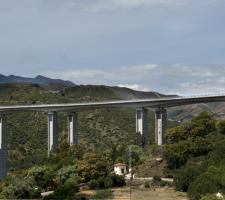
Julián Núñez, immediate past president of ASECAP, gets his teeth into the vision of a European strategy for toll roads. David Arminas reports from Madrid
Getting European politicians to agree to a long-term cross-border highway infrastructure programme for toll roads is extremely difficult. It’s a bit like pulling teeth: people want to avoid the pain.
But pain is something that Spanish operators, including
exit lane).
Many of the toll roads built prior to the financial downturn in the early 2000s suffered reduced traffic volumes as they competed for cash-strapped drivers heading for the free highways. Many of those run close to or parallel to the toll roads – and this is an issue for Julian Núñez, immediate past president of
Too late
Only now are toll road traffic volumes starting to recover but it has been too late for up to a dozen concessions that have gone, or are in the process of going, bankrupt. Some of these roads are being divested from the concessionaire as the parent group attempts to sell the rump business to investors as a going concern. In some cases, the divested toll roads are being taken over by a state-led group. But in July 2017, Spanish prime minister Mariano Rajoy announced a €5 billion public-private investment programme for around 2,000km of highways over the coming three years. Núñez is cautiously optimistic about the future, at least in Spain. The money will be for completing unfinished highways, with many tenders being on a 30-year maintenance contract. Around 190,000 jobs will be created, according to Rajoy.
At the time of the announcement, SEOPAN said government spending on infrastructure as a percentage of economic output was at record lows. Government-awarded infrastructure concessions in 2016 was a mere 2% of their value in 2007.
Is it a new dawn for Spanish toll road operators? Possibly. However, to avoid similarly dark financial days in the future, there need to be major changes in government-private sector relations - not just in Spain but right across Europe, he says.
Financial pressure
Spanish concessions were under financial pressure for several reasons. First there was the cost of expropriation of the land in the financially stressed toll roads. An estimated €800 million jumped up to around €2.2 billion, throwing financial plans out the window for many concessionaires. Government, too, panicked and halted its plans or looked to contractors and concessionaires to take on more responsibilities. “But when you increase investment, you need more time to recoup the investment,” he says.“Sometimes public administrators who manage construction of a toll road believe the money to build it is free and so anything can be done. For example, to improve the highway, you can just build another lane, or another bridge or tunnel. Remember, all this will eventually be paid for by road users.”
Add more construction and design demands and the private sector’s cost goes up. The original concession length may be too short to recover the increased investment demanded by the government.
At other times, the government would figuratively shoot itself in the foot, he explains. It would grant a concession for a toll road and then upgrade and improve the free local roads that often run beside the toll road - or even build a new road. This will siphon traffic off the toll road and throw into confusion traffic volume forecasts and jeopardise the private sector’s investment.
Volume failure
One example is OHL’s M12 motorway. The 9.4km toll road between Madrid and the city’s Barajas airport was opened in 2005 at a cost of around €380 million to OHL, according to a report by El Pais newspaper in 2014. However, expected traffic volumes failed to be reached as motorists preferred the free road that runs alongside it. OHL reportedly cited “construction and compulsory purchasing costs significantly higher than those predicted” and “extraordinarily low” traffic volumes for the road’s financial problems.
Núñez also points to a toll road between Madrid and Cordoba. After the concessionaire built the Madrid-Toledo section, the government pulled the plug on the other two sections to Cordoba. The effect was to have a “motorway to nowhere”, says Nunez. It is not that Toledo is unimportant - far from it. But Toledo is only 75km from Madrid and is well served by free roads, so the toll road is little used. Madrid to Cordoba is almost 400km.
To be fair, he says, these not-so-successful examples of failed toll roads can tarnish the very many that are a great success. Spain is not unique. Other European governments are under similar financial pressures and they often shift budgets from roads to other infrastructure, depending on perceived needs of their country.
Given that priority-changing tendency, Núñez says he has a vision for a long-term toll road strategy. “Never less than ten years,” he says. “We need a long-term strategy and politicians shouldn’t change the rules of the game in the middle of the game. Long term prioritisation of highways infrastructure should be at state level rather than a political one. It shouldn’t depend on the thinking of one political party in power and then another political party when it takes over. They should get together around the same table and hammer out a common strategy that won’t change if the government changes in the next five or so years.”
Núñez also extends his vision to being pan-European where a toll road strategy sits independently of national politics in EU member countries.
Why not? There is a strategy for free European roads north and south, east and west. What is needed is a similar strategy for toll roads. At the moment, one country’s toll road will stop at a border where drivers cross onto a free road. At a different border, two toll roads meet but they will have different physical road standards and toll payment systems.
OHL heads for the exit lane
OHL is out of the concessions business after finalising an agreement with Australian infrastructure group IFM Investors. Last October the companies announced that IFM will pick up OHL Concessions for nearly €2.3 billion, after adjustments.
Meanwhile, in December global hedge fund managers said they would pursue the Spanish government though the courts - Spanish and international - for years if need be, in order to get what they consider a fair payout over their investment in bankrupt toll roads. The companies said they are chasing around €4.5 billion invested in the nine roads whose operating companies went bust. The assets were taken over by the government.
For more than a year the government has been trying to set up a public company to operate the failed highways and also to drive down the payout to around €2 billion, according to news reports. Discussions continue on all fronts.
OHL Concessions manages 20 projects in Spain and Latin America, including 15 toll roads in Spain, Mexico, Chile, Peru and Colombia. It also operates Toluca Airport in Mexico and two light-rail urban lines in Spain.
Importantly, OHL’s deal with IFM excludes OHL Concessions’ two bankrupt projects, the metro rail line Ferrocarril Móstoles-Navalcarnero and the toll road Eje Aeropuerto-Access to T4 - otherwise known as the M12 motorway from Madrid to Barajas Airport. These remain subject to compensation with the government who would likely roll the toll road into a proposed highways public management company.
ASECAP priorities
As immediate past president of ASECAP, his priorities have been clear and three take precedence:
1) To inform the public about the advantages to them, including safety, and to the wider economy, of Europe’s 50,000km of toll roads.
Many travellers still question why there should be a toll. This attitude may not be as ingrained as in the US where the travelling public still hankers after roads built and maintained with tax money, such as the variable-by-state gas tax. He is keenly watching toll road development in the US, he says. His understanding is that while the US government is keen to invest in road infrastructure, that investment will be tied in some way to hefty investment from each state and with some form of private investment.
“We know that they have plans for more managed lanes,” Núñez says “But for managed lanes you need a lot of traffic [as in some parts of the US] and in Europe we have shorter distances to drive. So it is not so easy to develop managed lanes around European cities.”
2) To get more EU support, such as better cross-border legislation on toll road strategies and standards, as well as financing.
“At the moment there are only three or four EU directives detailing how you ‘apply’ a toll road,” he continues. “A lot of countries adapt these directives to suit their own national laws. The EU could be a little more involved in how these national laws are applied to toll concessions.”
This is part of his pan-European toll road vision that will make constructing and operating roads more of an even playing field for governments and the private sector. “In one country I pay a toll, in another country I don’t pay. I don’t know if the Eurovignette is the answer…in principle it is good. Maybe a different toll for heavy and light vehicles? What is more important is that this be harmonised across Europe.”
In Eurovignette countries - Denmark, Luxemburg, the Netherlands and Sweden - heavy goods vehicles with a gross vehicle weight of minimum 12 tonnes must buy a Eurovignette in order to use motorways and toll highways. Many other countries operate their own national non-cross-border vignettes.
A pan-European toll service that automatically handles any toll charges for any vehicle - heavy goods or passenger car - when crossing a border could also be part of the answer.
3) To push for more pan-European funding for toll road development.
“All the members of ASECAP have different visions of financing infrastructure. We need a common vision.”
The EU helped national governments during the recent recession with more money from the
Part of the wider Juncker Plan is the European Fund for Strategic Investments (EFSI) to provide an EU guarantee when mobilising private investment. This is done through the European Investment Bank but aimed mainly at small to medium size business.
Núñez on autonomous, electric and hybrid vehicles
“I don’t think toll road design will be much affected but in terms of information transfer to vehicles that will change. In-road charging is one possible development. A major step forward will be development of extremely fast battery recharging, in minutes, at, say a petrol station. This would be cheaper than introducing an ‘electric charge lane’ along a highway to avoid stopping to recharge. Maybe traffic lane marking will have to be much more accurate to ensure autonomous vehicles can read them. Perhaps there will be sensors embedded in the road to help the car know where it is exactly. There will be much more development in a tolled data-highway than the outward appearance of the highway itself.”













